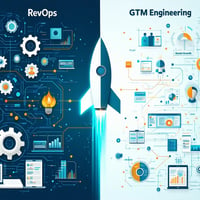Unlock Business Growth with RevOps and GTM Engineering Revenue growth is no longer just about...
How to Build Effective Lifecycle Processes for Your Business

Efficiency, alignment, and customer focus—these are the cornerstones of successful businesses, and achieving them often boils down to one thing: streamlined lifecycle processes. Whether you’re a RevOps professional, an SMB owner, or a business leader, building effective lifecycle processes is key to enhancing customer experiences and driving growth.
This guide will walk you through the essential steps to create lifecycle processes that feel seamless for your team and your customers. By the end, you’ll know how to map your customer journey, establish actionable workflows, and implement tools that unify your operations.
What Are Lifecycle Processes, and Why Do They Matter?
Lifecycle processes are structured workflows that guide your customers through every stage of their interaction with your business—from initial awareness to long-term advocacy. These processes ensure that each touchpoint is deliberate and effective.
Why are they important? When done right, lifecycle processes do more than make your business more efficient. They:
- Align teams across marketing, sales, and customer success.
- Enhance customer experiences by reducing friction at every stage.
- Improve metrics such as customer retention, lifetime value (LTV), and conversion rates.
Here’s an example in action:
A technology company that implemented clear stage gates and automated touchpoints saw a 25% reduction in customer onboarding time while increasing upsell opportunities by 15%. That’s the power of a great lifecycle process.
Now, let's break down the steps to build your own.
Step 1: Understand Your Customer Journey
Before you create processes, you need to deeply understand how your customers interact with your business:

Map the Journey
Start by documenting the full customer lifecycle, from awareness to advocacy. Consider these key stages:
- Awareness: How customers first encounter your brand.
- Consideration: What draws them deeper into evaluating your product.
- Decision: The moment they convert to customers.
- Retention: Where you delight them and encourage repeat business.
- Advocacy: Where they recommend you to others.
Ask yourself:
- What are the pain points at each stage?
- Where do prospects typically drop off?
- What actions lead to the next stage?
Collect Feedback
Speak directly with customers, run surveys, and analyze data from your CRM and analytics platforms. Their feedback will reveal behavioral patterns and areas to improve.
Pro tip: Use platforms like Lucidcharts to visually represent your customer journeys and identify opportunities.
Step 2: Map Key Touchpoints
Touchpoints are the moments when your customers interact with your business. These range from visiting your website to opening an email or talking to support.

Prioritize Impactful Touchpoints
Not every interaction is created equal. Identify the most critical touchpoints that influence customer decisions:
- Are prospects dropping off after receiving a proposal?
- Is onboarding where customers feel confused?
- What emails or messages lead to the most engagement?
Once you’ve mapped these out, focus your efforts on optimizing the most impactful ones.
Customize by Segment
If your business serves multiple types of customers, create tailored touchpoints for each. For example:
- Small business customers may require quick self-serve support.
- Enterprise customers may need more dedicated account management.
Remember, relevance is key—your messaging should align with the customer’s unique needs.
Step 3: Build Stage Gates
To ensure your lifecycle processes are effective, you need clearly defined criteria for moving customers through stages. These criteria—known as stage gates—help create consistency and prevent bottlenecks.

Define Stage Transition Criteria
For each stage of the lifecycle:
- Decide which customer actions trigger a stage change. (e.g., completing a demo call moves a lead from “prospect” to "opportunity.")
- Communicate these criteria with your team to ensure alignment across functions.
Automate Stage Transitions
Automated alerts and workflows help ensure smooth progression. For example:
- Use a CRM like HubSpot or Salesforce to notify your sales team when a marketing-qualified lead (MQL) requests a product demo.
Regularly Reevaluate
Customer behaviors change over time, so revisit your stage gates quarterly to ensure they’re still relevant and effective.
Step 4: Leverage Automation for Efficiency
Automation is a game-changer when it comes to lifecycle processes. It ensures that no lead or customer falls through the cracks while freeing up your team to focus on strategy.

Identify Tasks to Automate
Focus your automation efforts on repetitive, low-value tasks. Examples include:
- Lead nurturing emails for incoming prospects.
- Follow-ups for expired quotes or lapsed subscriptions.
- Data entry across systems.
Choose Your Tools Wisely
The right tools empower your automation efforts:
- For lead nurturing: Tools like ActiveCampaign, Mailchimp, or Klaviyo.
- For CRM integration: Use Salesforce, HubSpot, or Pipedrive.
- For workflow building: Platforms like Zapier streamline automation across multiple apps.
Pro tip: Automation should enhance human interaction, not replace it. Use it to support personalized engagement rather than reduce it.
Step 5: Analyze and Optimize Your Processes
Building lifecycle processes is not a one-and-done task. It requires continuous assessment and improvement.
Track Key Metrics
Monitor metrics that directly reflect the health of your lifecycle processes:
- Conversion rates between stages.
- Average time spent in each stage.
- Customer lifetime value (LTV) and churn rate.
For example, if customers are frequently churning within their first 90 days, revisit your onboarding process to see where improvements can be made.
Test and Iterate
Use A/B testing to refine your messaging, touchpoints, and workflows. For instance:
- Test email subject lines to see what drives more engagement.
- Experiment with different call scripts to improve close rates.
The goal is constant improvement, no matter how small the increment.
Step 6: Equip Yourself with the Right Tools
Tools are essential for building and managing lifecycle processes. Here’s a breakdown of must-haves:

- Flow Mapping: Use tools like Lucidcharts or Miro to visually map customer journeys.
- CRM Tools: Systems like HubSpot or Salesforce are foundational for managing touchpoints and automating workflows.
- Presentation Tools: Platforms like Google Slides, Beautiful.ai, or Pitch help you share and refine ideas with stakeholders.
- Documentation: Puzzleapp, Notion, and Scribe ensure everyone has access to up-to-date process documentation.
Make sure your tools integrate smoothly to avoid data silos.
Common Mistakes to Avoid
1. Neglecting Team Alignment: If your teams aren't on the same page, even the best lifecycle process will fail. Bring sales, marketing, and customer success together for routine check-ins.
2. Failing to Use Data: Decisions without data are guesswork. Prioritize clean, enriched data to inform every part of your lifecycle process.
3. Over-Automating: Too much automation can make interactions feel impersonal. Balance automated workflows with human touchpoints to maintain strong relationships.
Avoid these pitfalls, and your lifecycle processes will be set up for long-term success.
Final Thoughts
Building effective lifecycle processes is one of the most strategic actions your business can take. By understanding your customers, defining clear touchpoints, leveraging automation, and using data to optimize, you create a sustainable framework for consistent growth.
Ready to streamline your lifecycle processes without hiring a full-time team?
Chat with a fractional RevOps expert at On The Fly Ops—we’ll help you align, automate, and accelerate growth.
👉 [Book a 30-minute assessment call]





